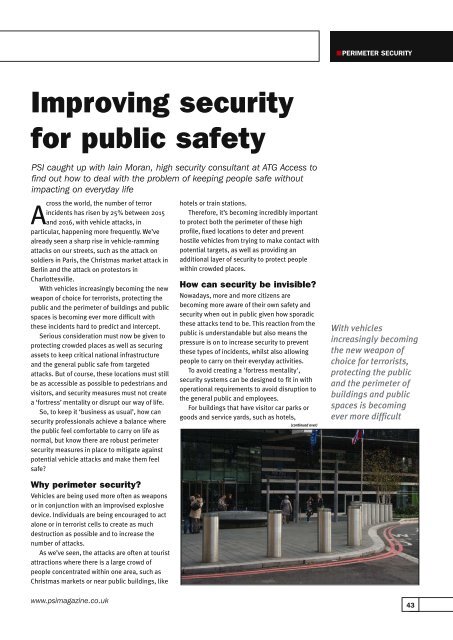PSISeptember2017a
Create successful ePaper yourself
Turn your PDF publications into a flip-book with our unique Google optimized e-Paper software.
PERIMETER SECURITY<br />
Improving security<br />
for public safety<br />
PSI caught up with Iain Moran, high security consultant at ATG Access to<br />
find out how to deal with the problem of keeping people safe without<br />
impacting on everyday life<br />
cross the world, the number of terror<br />
Aincidents has risen by 25% between 2015<br />
and 2016, with vehicle attacks, in<br />
particular, happening more frequently. We’ve<br />
already seen a sharp rise in vehicle-ramming<br />
attacks on our streets, such as the attack on<br />
soldiers in Paris, the Christmas market attack in<br />
Berlin and the attack on protestors in<br />
Charlottesville.<br />
With vehicles increasingly becoming the new<br />
weapon of choice for terrorists, protecting the<br />
public and the perimeter of buildings and public<br />
spaces is becoming ever more difficult with<br />
these incidents hard to predict and intercept.<br />
Serious consideration must now be given to<br />
protecting crowded places as well as securing<br />
assets to keep critical national infrastructure<br />
and the general public safe from targeted<br />
attacks. But of course, these locations must still<br />
be as accessible as possible to pedestrians and<br />
visitors, and security measures must not create<br />
a ‘fortress’ mentality or disrupt our way of life.<br />
So, to keep it ‘business as usual’, how can<br />
security professionals achieve a balance where<br />
the public feel comfortable to carry on life as<br />
normal, but know there are robust perimeter<br />
security measures in place to mitigate against<br />
potential vehicle attacks and make them feel<br />
safe?<br />
Why perimeter security?<br />
Vehicles are being used more often as weapons<br />
or in conjunction with an improvised explosive<br />
device. Individuals are being encouraged to act<br />
alone or in terrorist cells to create as much<br />
destruction as possible and to increase the<br />
number of attacks.<br />
As we’ve seen, the attacks are often at tourist<br />
attractions where there is a large crowd of<br />
people concentrated within one area, such as<br />
Christmas markets or near public buildings, like<br />
hotels or train stations.<br />
Therefore, it’s becoming incredibly important<br />
to protect both the perimeter of these high<br />
profile, fixed locations to deter and prevent<br />
hostile vehicles from trying to make contact with<br />
potential targets, as well as providing an<br />
additional layer of security to protect people<br />
within crowded places.<br />
How can security be invisible?<br />
Nowadays, more and more citizens are<br />
becoming more aware of their own safety and<br />
security when out in public given how sporadic<br />
these attacks tend to be. This reaction from the<br />
public is understandable but also means the<br />
pressure is on to increase security to prevent<br />
these types of incidents, whilst also allowing<br />
people to carry on their everyday activities.<br />
To avoid creating a 'fortress mentality',<br />
security systems can be designed to fit in with<br />
operational requirements to avoid disruption to<br />
the general public and employees.<br />
For buildings that have visitor car parks or<br />
goods and service yards, such as hotels,<br />
(continued over)<br />
With vehicles<br />
increasingly becoming<br />
the new weapon of<br />
choice for terrorists,<br />
protecting the public<br />
and the perimeter of<br />
buildings and public<br />
spaces is becoming<br />
ever more difficult<br />
www.psimagazine.co.uk<br />
43

















